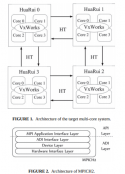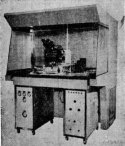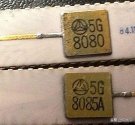Is there an announcement for CETC (w/r/t 45nm) or SMEE (w/r/t Yangtze)?China has a new Manufacturer of Lithography machines.
CETC (China Electronic Technology Corp) has developed a 45nm Lithograph and will be mass producing it this year at a new factory.
CETC manufactures Semiconductor machinery and is known for producing Ion Implanters.
CETC is a large Electronics Conglomerate and is well funded. We will see many new models of DUVL from them in the future.
Looks like SMEE has got some competition.
Recently SMEE won a contract from Yangtze Memory to supply a unit of their new 28nm Immerssion DUVL. Most likely to be used for the expansion of their 3D NAND production.
You are using an out of date browser. It may not display this or other websites correctly.
You should upgrade or use an alternative browser.
You should upgrade or use an alternative browser.
Chinese semiconductor industry
- Thread starter Hendrik_2000
- Start date
- Status
- Not open for further replies.
I think the same goes with CXMT. They use the 22nm+ process in making their products so the SMEE 28mm DUVL would be the perfect solution to their needs.
Not only that, alot of locally made 14nm to 28nm capable Semiconductor machinery is becoming available and the timing is right for these companies to ramp up production using indigenous equipment.
Yangtze Memory is getting the SMEE 28nm DUVL. CETC will probably supply their 45nm DUVL to Huawei.Is there an announcement for CETC (w/r/t 45nm) or SMEE (w/r/t Yangtze)?
More players involved the better. CETC is a huge state enterprise with many research groups and companies.
Its Soul Core DSP chips are powering all the Chinese radar system.
I think it manufactures its own chips. So developing lithography equipments for its own fab make sense especially they are for military. So it can validate its own equipment with it's own chip products.
the 45nm equipment coincide with Huawei starting fab. Its only getting it's feet wet on this.
Since SMEE already have the 28nm, CETC should target the next product at 14nm with single exposure.
CETC is much more resourceful than SMEE. It definitely can beat SMEE on EUV.
Soul Core is one of the DSP families used by Chinese military. Another is the Huarui DSP, first introduced in 2012.
Huarui DSP family is used with Institute 14 radars such as J-10A/B/C, J-11B, Type 346 radars on 052C/D/055.
It is designed and used by Institute 14 which is NRIET which is part of CETC.
CETC and military institutes likely use custom or boutique fabs and do not depend on civilian fabs for production.
SLC-7 mentioned here is an AESA radar used by PLA, and it goes back to the SLC-2 which is among the earliest AESA radars used by PLA at the turn of the century.
Huarui 2 uses 40nm process in 2018.
Science and Technology Daily, Nanjing, June 14 (Reporter Zhang Ye, Correspondent Shi Rujia) From the 14th, a large number of military and civilian radars and related electronic products will be unveiled in Nanjing, the 8th World Radar Expo and the 9th Military and Civil Dual-use Electronic Information Technology Exhibition Kicked off. Among them, the DSP chip independently developed by China Electronics Technology Group 14-Huarui No. 2 and the radar network center are the first to be disclosed to the public.
Huarui No. 2 is a major high-end chip project of the country's "Twelfth Five-Year Plan" nuclear high base, which just passed the subject acceptance a month ago. It marks that my country has made another major breakthrough in the development of high-end DSP (digital signal processing technology).
According to Li Ming, the chief expert of the 14th Institute, Huarui No. 2 chip adopts 40 nanometer technology, works at 1GHz, can complete 400 billion floating-point operations per second, supports 64-bit standard double-precision, and its comprehensive processing performance is better than international mainstream DSP chip. In order to meet the needs of anti-stealth detection, Hua Rui 2 adopts an 8-core heterogeneous design, specially adapted to anti-stealth algorithms. At the same time, for applications with different performance requirements, Huarui No. 2 high-end and mid-range products have been formed, which are comprehensively promoted and applied in civilian fields such as security monitoring, security computers, and military fields such as radar, communications, and electronic countermeasures.
A seemingly "container" shelter at the exhibition site became the focus of the audience, which is the regional command system networking center. It is like a human brain that can integrate multiple radar equipment with different systems, different frequency bands, and different functions to monitor and track air targets, identify and threaten them, and organize air defense resources for air defense operations. Can undertake typical large-area air defense combat missions.
As an optional supporting radar for the networking center, my country's newly developed fourth-generation radar SLC-7 also appeared at the exhibition. SLC-7 is a typical all-rounder radar, with powerful multi-purpose capabilities, it is easy to deal with stealth aircraft, missiles, drones and other targets.
SLC-7 also has the characteristics of autonomous combat and super anti-jamming capabilities: for example, radar can be set up almost with one button, can autonomously implement target capture and recognition, and can automatically switch combat scenarios to minimize the role of human , And improve the anti-interference ability from multiple technical levels.
2014 paper on MPI (Message Passing Interface) with Huarui 1 DSP.
Huarui 1 DSP has four cores. Using MPI, multiple Huarui 1 can be joined for a scalable multicore architecture. In paper, VxWorks is used as the RTOS.

Huarui 1 should be used with NRIET radars from 2012 onwards. Chances are things like J-10s to Type 052Ds might be using it.
Huarui 2 is an octacore introduced in 2018, 40nm process, 1GHz speed, 400 Gigaflops. Likely seen in radars from 2018 and above, as well as in retrofit upgrades to older existing radars. Chances are things like J-20 or the Type 055 might be using this.
Huarui 3 is currently underdevelopment, achieves 1 Teraflop and has AI support.
The cores use MIPS64 RISC, so likely Loongson is involved.
Speaking of which, here is an old but good article here.
Loongson started out with MIPS but has gradually evolved far beyond the MIPS instruction set. One way to put it as an analogy, is how the Sino-Flanker has evolved into the J-16 from the basic Su-27SK beginnings.
Huarui 1 DSP has four cores. Using MPI, multiple Huarui 1 can be joined for a scalable multicore architecture. In paper, VxWorks is used as the RTOS.

Huarui 1 should be used with NRIET radars from 2012 onwards. Chances are things like J-10s to Type 052Ds might be using it.
Huarui 2 is an octacore introduced in 2018, 40nm process, 1GHz speed, 400 Gigaflops. Likely seen in radars from 2018 and above, as well as in retrofit upgrades to older existing radars. Chances are things like J-20 or the Type 055 might be using this.
Huarui 3 is currently underdevelopment, achieves 1 Teraflop and has AI support.
The cores use MIPS64 RISC, so likely Loongson is involved.
Speaking of which, here is an old but good article here.
Loongson started out with MIPS but has gradually evolved far beyond the MIPS instruction set. One way to put it as an analogy, is how the Sino-Flanker has evolved into the J-16 from the basic Su-27SK beginnings.
Lithography today is very different than back then.Remembering the good ole days when China was self sufficient.
China self developed lithography equipment in 1978 , the GK3 modelView attachment 67480
Using its own equipment it cloned the Intel 8080 CPU and named as 5G8080
View attachment 67481
Man whenever I see fab equipment i get emotional about the graduate school days.Lithography today is very different than back then.
I just went browsing for used equipment lol:
Sadly I haven't been trained for stuff under 500nm.
Lithography today is very different than back then.
I don't think that's his point lol
I know, but I feel like there’s some “China shouldn’t have gotten off the lithography bandwagon we could have gotten the lead if we just stuck with it from the 80s” sentiment when there’s callback to that history and...I guess I’m just a party pooper.I don't think that's his point lol
- Status
- Not open for further replies.


